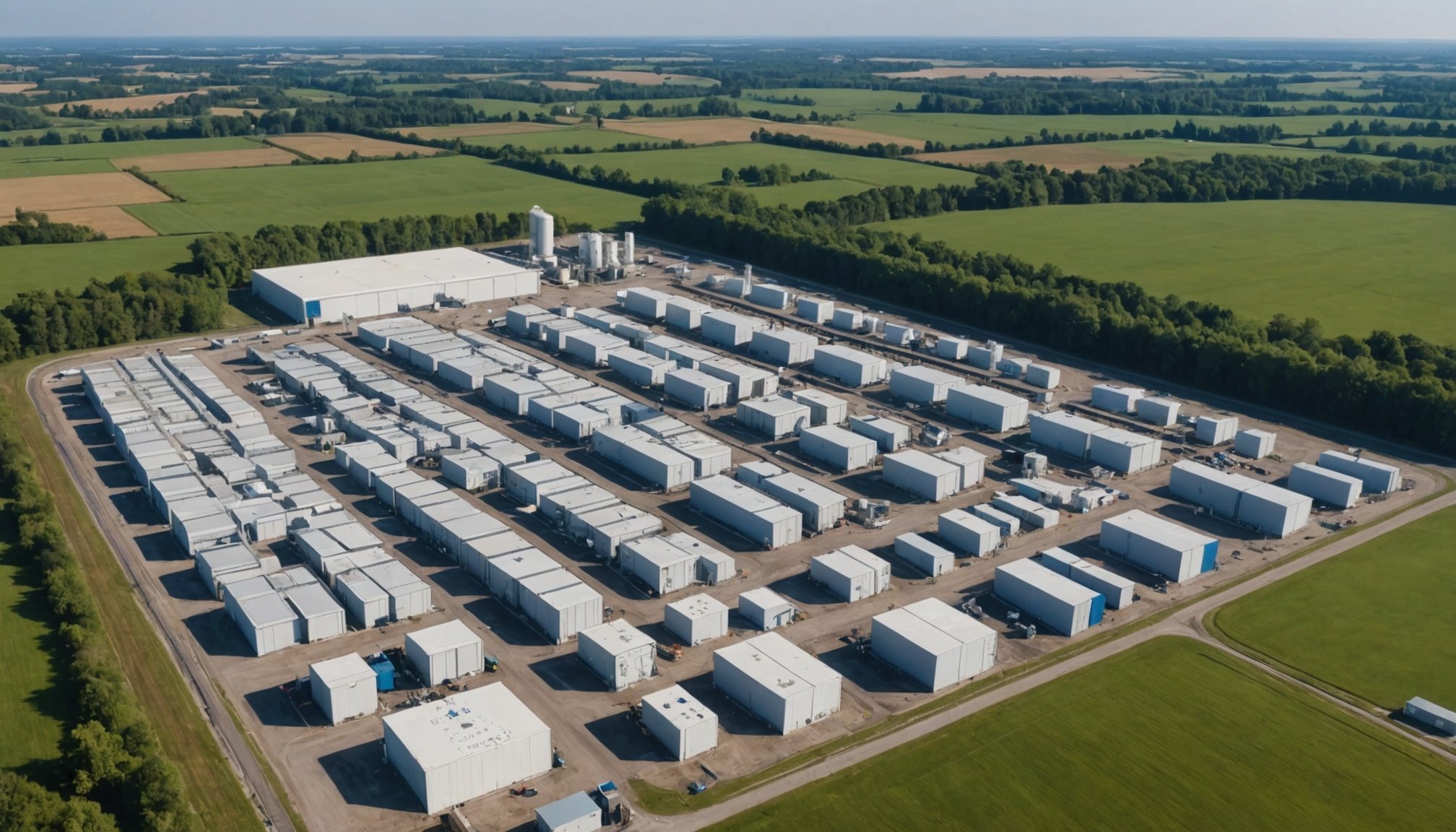Hydrogen’s potential as a clean energy source hinges on efficient, safe storage solutions that overcome its low volumetric density. Innovative methods—from high-pressure tanks to advanced materials—are reshaping storage technology, enabling practical applications in transportation and industry. Exploring these breakthroughs reveals how meeting demanding performance and cost targets brings us closer to a truly sustainable hydrogen future.
Meeting the Critical Need for Safe and Efficient Hydrogen Storage Solutions
In the push toward industrial decarbonization and cleaner transport, hydrogen storage stands out as a linchpin technology. Right after renewable energy production, storing hydrogen efficiently determines whether it can truly serve power grids, heavy industry, or mobility. For professionals seeking to support the clean energy transition, discover the benefits of hydrogen storage solutions with vallourec as the landscape evolves rapidly to meet ambitious renewable and emissions targets.
Also to read : How Do UK Businesses Navigate Post-Brexit Challenges?
Hydrogen’s exceptional gravimetric energy density—nearly three times greater than gasoline—enables flexible fuel solutions, but its low volumetric energy density creates distinctive challenges. Compressed hydrogen storage in high-pressure tanks is currently favored for fuel-cell vehicles and industrial use, often employing advanced fiber-reinforced composites to safely withstand pressures up to 700 bar. The challenge lies in optimizing these vessels for both cost and usable onboard space, especially as storage must remain compact, efficient, and safe for everyday and large-scale applications.
Manufacturers and policy makers are turning their attention to advanced liquid, compressed, and materials-based strategies. Liquid hydrogen storage, while demanding cryogenic temperatures near -253°C, dramatically reduces storage volume but necessitates specialized facilities. Meanwhile, innovations in material-based storage—such as solid-state hydrides—promise substantial density improvements and ease integration with renewable generation for grid balancing or backup power.
Also read : What are the strategies for UK businesses to build a strong online presence?
Safety is foundational in hydrogen storage system design. Rigorous hydrogen storage safety standards drive adoption of robust leak detection, effective ventilation, and material choices that resist hydrogen embrittlement. As regulations mature and safety requirements become more stringent, engineering solutions are increasingly reliant on digital monitoring and modularity to deliver dependable performance.
Across applications, energy transition stakeholders expect storage technologies that blend flexibility with sustainability—serving utility microgrids, refueling stations, distribution hubs, or even off-grid scenarios. As the sector advances, next-generation hydrogen storage promises to unlock a greener, more resilient energy ecosystem for 2025 and beyond.
Overview of Hydrogen Storage Technologies and Methods
Hydrogen energy storage methods are categorized primarily by how hydrogen is contained and delivered for use. The most established approach is compressed hydrogen storage. This uses high-pressure hydrogen tanks, commonly set between 350 and 700 bar, to boost volumetric density. While compressed hydrogen storage remains the preferred choice for vehicle and industrial use, tank size and overall storage system design must balance safety, efficiency, and cost. Robust hydrogen storage safety standards govern these systems, ensuring leak prevention and resistance to hydrogen embrittlement.
Liquid hydrogen storage technology offers an alternative by cooling hydrogen to -253°C. This cryogenic process enables higher volumetric density than compressed hydrogen storage, but requires specialized infrastructure including insulated tanks and precise hydrogen storage thermal management. Due to boil-off and thermal risks, implementing hydrogen storage safety standards is key when designing and operating these systems.
Material-based solutions enhance hydrogen energy storage methods through innovations such as solid-state hydrogen storage, metal hydride storage systems, and chemical hydrogen storage. Metal hydride storage systems chemically bind hydrogen within solid materials at moderate pressures and temperatures, enabling safer handling. Chemical hydrogen storage methods, like ammonia, function as hydrogen carriers, addressing issues of density and ease of transport. Emerging hydrogen adsorption techniques and solid-state hydrogen storage strategies aim to solve weight and cost concerns, with ongoing research focused on safe, practical, and scalable deployments.
Comparative Analysis: Technical and Economic Performance of Storage Methods
Storage capacity and energy density performance
Hydrogen storage technologies comparison shows clear contrasts in energy density and storage capacity optimization. Compressed hydrogen storage at high-pressure (350–700 bar) achieves respectable gravimetric energy density, supporting applications like hydrogen storage for fuel cells in vehicles. However, the volumetric energy density remains low, challenging for maximizing space in mobile uses. Cryogenic hydrogen storage improves volumetric density but demands significant energy for cooling, while metal hydride storage systems boost density further, albeit with increased weight and slower filling rates.
Cost and efficiency trade-offs
Hydrogen storage cost analysis reveals that material-based storage remains more expensive due to advanced hydrogen storage methods and specialized hydrogen storage materials. Compressed tanks, though mature, require costly high-pressure hydrogen tanks, and liquid hydrogen storage technology incurs high operational expenses from chilling. Long-term, optimizing hydrogen storage for renewable integration depends on scalable hydrogen storage systems balancing expenditure with efficiency—including energy consumption for hydrogen compression technology or refrigeration.
Durability, leakage risks, and life cycle assessment
Hydrogen storage durability impacts hydrogen storage system maintenance and long-term economics. High-pressure systems face hydrogen diffusion and embrittlement, shortening tank life. Metal hydrides and other solid-state hydrogen storage methods can improve hydrogen storage leakage prevention and offer near-unlimited charge/discharge cycles. Comprehensive hydrogen storage life cycle assessment is essential, examining not only operational but also environmental impacts on hydrogen storage and carbon footprint reduction. Safety, reliability, and efficiency drive sustainable hydrogen storage technologies forward.
Safety, Standards, and Regulatory Requirements in Hydrogen Storage
Key safety risks: Flammability, leaks, embrittlement, and thermal runaway
Hydrogen storage safety standards address several risks: flammability, undetectable leakage, and material embrittlement. Hydrogen’s high diffusivity means even minor flaws can escalate to hazardous leaks. Containers must counter leakage and resist embrittlement, especially at high pressure or extreme cold. Thermal runaway is less likely in low-pressure hydride systems, but in high-pressure gas containers, sudden temperature spikes can cause rapid gas expansion. Effective hydrogen storage safety risk management therefore targets strict gas-tight seals, robust metallurgy, and real-time detection systems.
Compliance with global standards and certifications
Meeting hydrogen storage regulatory requirements involves complying with codes developed by bodies like ISO and SAE, ensuring that hydrogen storage container safety features meet globally recognized criteria. Areas regulated include maximum storage pressure, validated leak prevention, periodic vessel inspection, and monitoring system standards. For example, ISO 16111 covers container construction and operational parameters for onboard storage. Certification not only keeps users safe, but also enables international deployment and adoption of hydrogen storage system design for new infrastructure projects.
Advances in detection, monitoring, and containment solutions
Modern hydrogen storage safety standards demand advances in detection and monitoring. Digital sensors now monitor pressure, temperature, and hydrogen concentration around storage tanks continuously. Automated alarm and venting systems mitigate escape or overpressure events. Hydrogen storage container safety features increasingly integrate real-time telemetry—vital for both permanent and portable hydrogen storage units—not just meeting but exceeding regulatory requirements for safety across storage applications, from transportation to grid support.
Real-world Applications and Industrial Use Cases
Automotive and fuel cell vehicles: Range, refueling, and tank integration
Hydrogen storage for fuel cells in vehicles depends on advanced high-pressure hydrogen tanks and optimized hydrogen storage system design. The process prioritizes volumetric and weight efficiency to maximize range, aiming for a minimum 300-mile driving target by holding 5–13 kg of hydrogen onboard. Fuel cell electric vehicles rely on compressed hydrogen storage at up to 700 bar, but this puts pressure on vehicle space and weight. Continued research into solid-state hydrogen storage and hydrogen storage materials aims to further improve tank integration and hydrogen storage for transportation needs while addressing hydrogen storage safety standards.
Grid, utility, and microgrid solutions: Energy shifting and backup power
Hydrogen storage for power plants allows the grid to efficiently balance renewable energy supply with demand. Metal hydride storage systems and compressed hydrogen storage support rapid discharge and long-duration energy reserves, enabling utility-scale backup. This use case expands across hydrogen storage application sectors, securing off-grid hydrogen power storage and stabilizing microgrids with optimized hydrogen storage system design. Technologies like modular storage containers simplify site installation and vertical scalability for urban resilience or remote reliability.
New frontiers: Data centers, synthetic fuels, ammonia, and maritime transport
Hydrogen storage for industrial use is advancing rapidly. Data centers benefit from off-grid hydrogen power storage ensuring reliable backup. Meanwhile, ammonia and synthetic fuel production utilize hydrogen storage for renewable integration, supporting chemical conversion processes in novel sectors. In maritime transport, scalable hydrogen storage systems support bunkering and ferry refueling operations. These new hydrogen storage application sectors show the flexibility and broad reach of advanced hydrogen storage for fuel cells.
Market Trends, Research Developments, and Infrastructure Expansion
DOE/HFTO Targets and Global Research Priorities
Hydrogen storage market outlook research confirms enormous focus on developing practical hydrogen storage infrastructure for energy transition. The U.S. DOE’s Hydrogen and Fuel Cell Technologies Office (HFTO) continues to set aggressive targets, including achieving a 300+ mile driving range, cost reductions to $333/kg hydrogen stored, and systems with at least 1.5 kWh/kg energy capacity. Hydrogen storage research trends prioritize advanced hydrogen storage materials, compressed hydrogen storage, metal hydride storage systems, and high-pressure hydrogen tanks. Internationally, researchers collaborate on solid-state hydrogen storage, liquid hydrogen storage technology, and cryogenic hydrogen storage. Material compatibility and optimizing hydrogen storage pressure levels remain critical research themes globally.
Major Demonstration Projects and Supplier Innovations
Demonstration projects showcase hydrogen storage infrastructure scalability. Notable examples include salt cavern-based hydrogen storage for grid balancing and commercial demonstrators such as the Delphy hydrogen storage solution, able to store up to 100 tons with rigorous hydrogen storage safety standards. Innovation funding spurs solid-state hydrogen storage development and advanced hydrogen storage methods, while system integration efforts connect hydrogen storage for power plants and renewable energy and hydrogen storage.
Scaling up: Infrastructure, Logistics, and Investment Realities
The hydrogen storage market outlook is shaped by growing investment in scalable hydrogen storage systems. Large-scale deployments—both above and underground—address hydrogen storage challenges, emphasizing hydrogen storage durability, leak prevention, and efficient hydrogen storage system design. Global supply chains evolve to support hydrogen storage for transportation, industry, and off-grid hydrogen power storage, combining project financing, hydrogen storage innovation funding, and advances in hydrogen storage infrastructure.
Future Challenges and Opportunities in Hydrogen Storage Innovation
Overcoming Volumetric and Gravimetric Density Barriers
Advanced hydrogen storage methods struggle with the fundamental challenge of high gravimetric energy but low volumetric density. Current high-pressure hydrogen tanks, while effective for hydrogen storage for transportation, occupy substantial space and impact vehicle design. To optimize hydrogen storage capacity, researchers are pursuing material-based storage solutions such as metal hydride storage systems and solid-state hydrogen storage. These can deliver energy efficiency in hydrogen storage by packing more hydrogen per unit volume, but often at the cost of weight or slower release rates.
Environmental Impact, Lifecycle, and Climate Change Mitigation
Sustainable hydrogen storage technologies not only target performance but also minimize environmental impact throughout their lifecycle. Hydrogen storage and environmental impact evaluations show that deploying hydrogen storage for renewable integration can firm clean power supplies and avoid fossil fuel reliance. Life cycle assessment of hydrogen storage system design examines raw material sourcing, end-of-life recyclability, and greenhouse gas emissions. Green hydrogen, stored using sustainable hydrogen storage technologies, delivers decarbonization in sectors where electrification remains impractical.
Technological Breakthroughs Shaping the Next Decade
Progress in hydrogen storage innovations centers on combining safety, high density, and flexibility for emerging uses. Decentralized hydrogen storage solutions, such as modular underground infrastructure, enable scalable hydrogen storage systems. Breakthroughs in hydrogen storage materials offer better adsorption, less leakage, and durability for off-grid hydrogen power storage and smart grid balancing. Continued research into advanced hydrogen storage methods will drive down costs, increase efficiency, and enable hydrogen storage for renewable integration at the grid and consumer levels.


